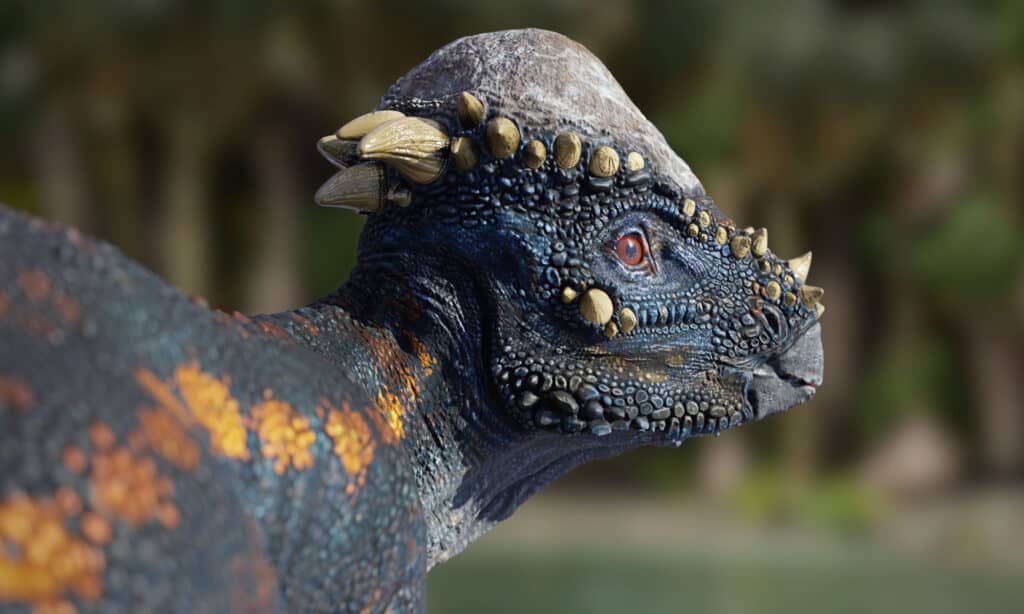
A Bonehead with an Unknown Purpose
The name pachycephalosaurus means “thick-headed lizard,” and it’s appropriate. The tops of these guys’ skulls were a whopping nine inches thick! Compare this to the length of a dollar bill, which is only 6 inches long, and you’ll see what an insane amount of armor this really was! At the edges of this skull plate were bony spikes sticking out in all directions, but these were blunt, not sharp.
Since the creature was discovered, a popular hypothesis is that rival males rammed their heads together like bighorn sheep. Others have suggested they head-butted in self-defense, to ram attacking carnivores in their flanks, for example. A problem with these theories is that the animal had an s-shaped neck rather than a straight one, so it’s not clear that it could have transmitted a lot of force from its body through its neck to its head to achieve the desired effect. So, for now we’re still just not sure how that bonehead was used for anything more than protecting its very tiny skull.

The “dinosaur with a hard head” also had a curved neck, so it’s not clear that it could have rammed anything with very much force with its head.
The Dinosaur with a Hard Head Also Had a Body
We focus so much attention on the hard head of this dinosaur, what about the rest of its body? It also has some wonderful weirdnesses to it. Pachycephalosaurus walked on two large back legs and had small forearms much like a tyrannosaurus rex. Its tail was relatively short and rigid. They were about 15 feet long and weighed up to 990 pounds. This is about the same size as an adult male American alligator. Because the eye sockets in the skull are rounded and face forward, researchers think they had good eyesight and binocular vision. This would have helped it spot food and keep an eye out for predators.
The creature’s muzzle ended in a pointed beak, like a bird, and it had tiny sharp serrated teeth. Scientists aren’t certain exactly what it ate, but they could not have chewed on tough things like tree branches the way larger herbivorous dinosaurs could. They probably ate leaves, seeds, and fruit. But in fact, they may have been omnivorous. They had serrated blade-like front teeth that were similar to carnivorous theropods. Feral pigs are an example of a modern omnivorous species like this. So again, pachycephalosaurus leaves us with some mysteries.

Researchers aren’t certain about the diet of the pachycephalosaurus, as its teeth show characteristics of both herbivores and carnivores.
What Happened to These Funny Guys?
It’s hard to think of pachycephalosaurus without personifying him as a lovable jock who has taken a few too many hits to the head, will eat anything and take any dare, and hey, if a jeep with a poacher is around, he has no problem ramming into that too. Somehow, it seems like it would be some chaotic fun to have one around. But there’s no chance. The last of them died out about 66 million years ago in a great extinction attributed to a meteor impact in the Yucatan Peninsula of Mexico.
So, is there any chance of bringing them back, as they did in Jurassic Park? No. Sorry. That is truly just science fiction. DNA is fragile and cannot survive, even in blood in a fossilized mosquito, for millions of years. There is more hope that more recently extinct creatures could be brought back, including maybe woolly mammoths, but they would never be true mammoths, but instead mammoth-elephant hybrids bred to reproduce prehistoric characteristics as much as possible. But as for the pachycephalosaurus, well, the best you can do is watch the movies.